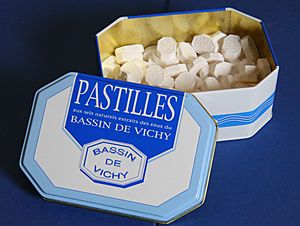Vichy Pastilles facts for kids

A box of Vichy Pastilles.
|
|
| Type | Confectionery |
|---|---|
| Place of origin | France |
| Region or state | Vichy |
Vichy Pastilles (French: pastilles Vichy) are a type of candy from France. They were first made in 1825 in the town of Vichy, which is famous for its special spring water. You can easily spot them because they are white and shaped like an octagon. Each pastille has the word "Vichy" written on it in capital letters.
These candies are a well-known treat from central France. They are often enjoyed for their unique taste and history.
Contents
Who Owns Vichy Pastilles?
The company that makes Vichy Pastilles has changed hands a few times over the years. In 1940, the brand belonged to the Vichy-État Company. Later, in 2003, a company called Cadbury France bought it.
After that, it became part of Kraft Foods, which is now known as Mondelez International. Most recently, in 2016, a French company called Eurazeo bought the brand. They paid 250 million euros for it.
The Story of Vichy Pastilles
How They Were Invented
Vichy Pastilles were created in 1825 in the town of Vichy, France. This town is known for its natural spring waters. At first, these pastilles were made only from bicarbonate of soda. People took them to help with their digestion, which means helping their stomachs break down food.
It is said that Empress Eugénie de Montijo, a famous historical figure, really liked these candies.
Changes Over Time
Later on, the pastilles started to include mineral salts. These salts were taken directly from the special spring water in Vichy. Today, Vichy Pastilles also have sugar in them. You can find them in different flavors like mint, lemon, or aniseed.
Vichy Pastilles in Books
The famous French writer Guy de Maupassant even mentioned these pastilles in one of his short stories. The story was called The Magic Couch.
During World War II, the sweets were used by the government of Vichy France for "branding and marketing." In August 1942, shops in Vichy gave these pastilles to customers. This happened even when other foods were hard to get because of rationing. The mayor of Vichy even decided to mark the sweets as cheese on ration cards. This was done to make sure they did not run out.
Some authors have written about how these candies are seen today. American author Alexander Theroux wrote in his book Einstein's Beets: An Examination of Food Phobias that some French people still feel a bit uneasy when they hear the phrase "Vichy Pastilles." This is because of their connection to that difficult time in history. Manuel Bragança and Peter Tame agreed in their book The Long Aftermath: Cultural Legacies of Europe at War, 1936-2016. They said that the use of the sweets for propaganda eventually "backfired."
See also
 In Spanish: Vichy (pastillas) para niños
In Spanish: Vichy (pastillas) para niños

